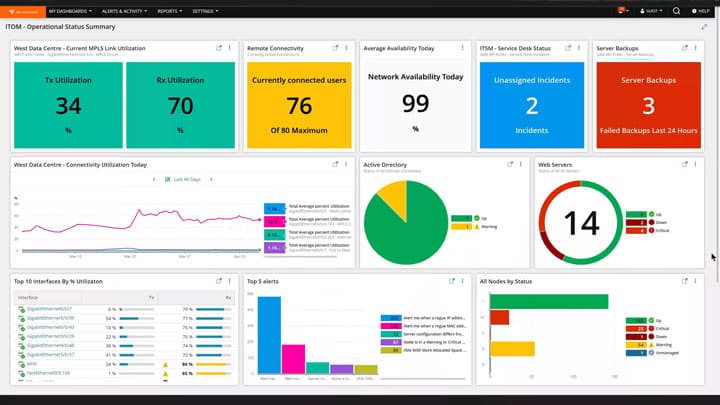We may earn a commission if you make a purchase through the links on our website.
The Best Hybrid Cloud Observability Tools
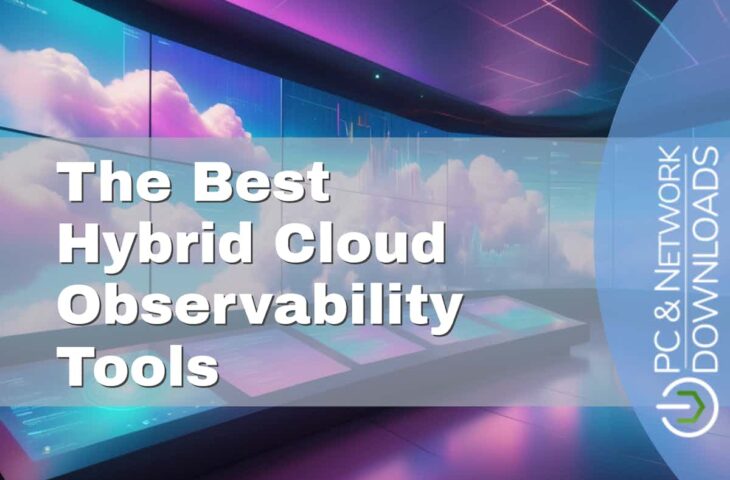
UPDATED: May 10, 2024
Keep tabs on your hybrid environment with these hybrid cloud observability tools.
As more businesses transfer their activities to the cloud, managing and monitoring their infrastructure and applications becomes more difficult. This is especially true in hybrid cloud setups, which combine public and private cloud services as well as on-premises infrastructure. IT teams want solutions that enable complete observability across all layers of the stack, including infrastructure, applications, and services, to properly monitor and manage these complex environments.
Here is our list of the best Hybrid Cloud Observability Tools:
- SolarWinds Hybrid Cloud Observability – FREE TRIAL Provides end-to-end visibility into cloud infrastructure and applications, enabling IT teams to quickly identify issues and optimize performance. Start a 30-day free trial.
- Datadog A cloud-based monitoring platform that provides visibility into infrastructure, applications, and logs across hybrid and multi-cloud environments.
- Dynatrace An AI-powered observability platform that provides real-time insights into the performance of cloud-native applications and infrastructure.
- New Relic Cloud-based observability platform that provides real-time insights into the performance of modern applications and infrastructure, including containers and microservices.
- Splunk A platform that provides visibility into logs, metrics, and events across hybrid and multi-cloud environments. It enables IT teams to monitor, troubleshoot, and optimize the performance of their applications and infrastructure.
- AppDynamics Application performance monitoring platform that provides visibility into the performance of applications and infrastructure across hybrid and multi-cloud environments. It enables IT teams to quickly identify and resolve issues before they impact the end-user experience.
- Sysdig Monitor A cloud-native observability platform that offers end-to-end visibility into the performance of cloud environments.
IT teams can employ hybrid cloud observability technologies to acquire real-time insights into the performance and health of their cloud systems, allowing them to identify and resolve issues before they influence users or business operations. These technologies provide a holistic view of the complete environment by monitoring metrics, logs, and traces, allowing IT professionals to proactively identify and address any issues.
There are several important considerations to consider when choosing a hybrid cloud observability tool. To begin with, the tool should be capable of monitoring and collecting data from all components of the hybrid cloud environment, including public cloud services, private cloud infrastructure, and on-premises systems. This information should be shown in a unified dashboard that serves as the environment's single source of truth.
The application should also be able to analyze this data in real-time and provide alerts and notifications when problems are found. Machine learning and artificial intelligence capabilities can aid in the automation of the analytical process, making it more efficient and accurate. Another critical factor to consider is the capacity to visualize data and deliver actionable insights. The platform should be capable of delivering intuitive and customized dashboards, reports, and visualizations that enable IT teams to immediately spot issues and track performance over time.
Collaboration and communication capabilities are also essential for hybrid cloud observability solutions. The technology should make it simple for IT teams to share data and insights, as well as collaborate on troubleshooting and remediation operations. Chatops skills can also be valuable for automating routine chores and improving team communication.
The Best Hybrid Cloud Observability Tools
1. SolarWinds Hybrid Cloud Observability – FREE TRIAL
SolarWinds Hybrid Cloud Observability is a robust observability tool developed to help IT teams monitor and optimize the performance of their cloud infrastructure and apps. The platform offers complete visibility into hybrid and multi-cloud settings, allowing IT professionals to instantly identify problems and enhance performance.
Key Features:
- End-to-end visibility
- Real-time insights
- Multi-cloud support
- Anomaly detection
- Advanced analytics
The ability to monitor different clouds and on-premises systems from a single dashboard is one of the most important advantages of SolarWinds HCO. This implies that IT teams may gain a comprehensive perspective of their whole infrastructure, no matter where it is located. The platform also gives real-time insights into the performance of apps, infrastructure, and networks, allowing IT teams to discover and rectify issues before they negatively influence end-user experience.
Support for prominent cloud platforms such as Amazon Web Services (AWS), Microsoft Azure, and Google Cloud Platform is another aspect of SolarWinds HCO. The platform offers pre-built dashboards and data for each cloud platform, allowing IT teams to easily manage their infrastructure and apps. Furthermore, SolarWinds HCO provides machine learning-based anomaly detection, which may discover and warn IT teams of performance concerns automatically. The platform also features powerful analytics and reporting capabilities, allowing IT professionals to acquire a better understanding of their infrastructure and applications' performance.
SolarWinds Hybrid Cloud Observability pricing is dependent on the number of monitored cloud instances, with costs starting at $3,395 per year for up to 50 instances. The platform also provides a free trial, allowing IT teams to test the platform's capabilities before making a purchase. The intricacy of SolarWinds HCO could be a disadvantage. The platform has a plethora of features and capabilities, which might be overwhelming for IT professionals who are unfamiliar with the technology. Furthermore, some customers have noted that the platform's user interface can be difficult to use, making it difficult to rapidly obtain the information they require.
All in all, SolarWinds Hybrid Cloud Observability is a robust observability product with numerous features and capabilities. Its ability to monitor different clouds and on-premises environments from a single dashboard makes it a vital tool for IT teams who need to manage complicated hybrid and multi-cloud settings. While some users may find the platform's complexity and user interface challenging, its advanced analytics, reporting, and machine learning-based anomaly detection capabilities make it a worthwhile investment for IT teams looking to optimize the performance of their cloud infrastructure and applications.
2. Datadog
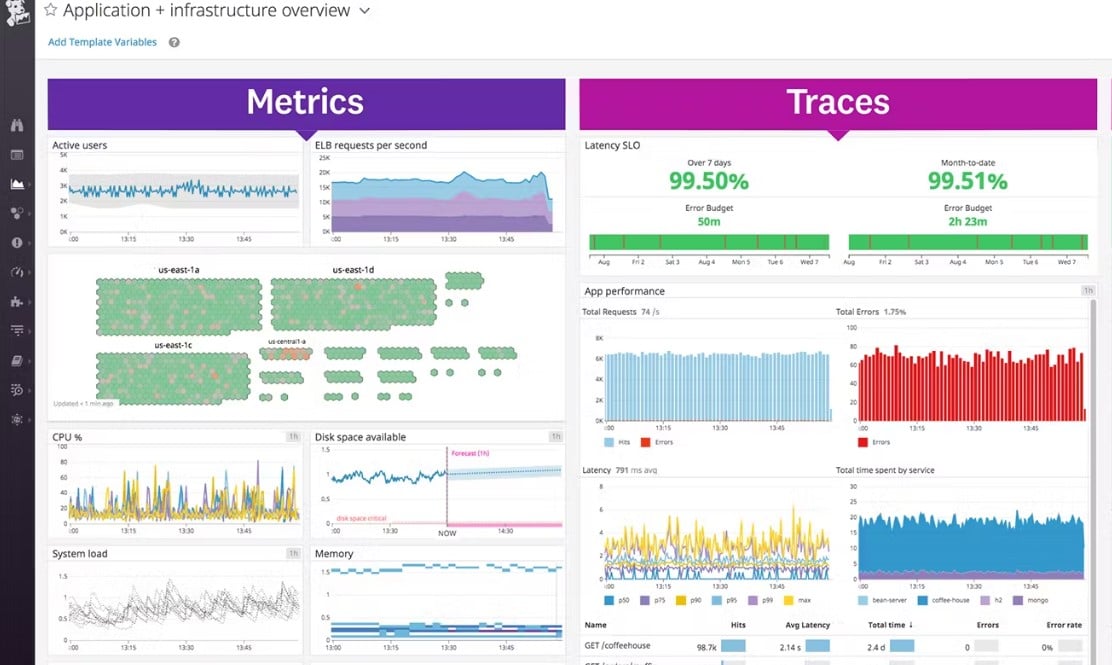
Datadog is a cloud-based monitoring tool that gives visibility into hybrid and multi-cloud infrastructure, apps, and logs. The platform has a diverse set of features and capabilities, making it a popular choice for IT teams trying to monitor and improve the performance of their infrastructure and apps.
Key Features:
- Multi-cloud support
- Container monitoring
- Anomaly detection
- Advanced analytics
- Log management
Datadog's ability to monitor a wide range of cloud systems, including Amazon Web Services (AWS), Microsoft Azure, and Google Cloud Platform, is one of its most notable characteristics (GCP). The platform has pre-built connections for each cloud platform, allowing IT teams to monitor their infrastructure and applications quickly and efficiently.
Datadog also supports containers and microservices, which is an important feature. The platform contains several tools and capabilities that are specifically developed for monitoring containerized apps and microservices, making it a valuable tool for enterprises that are using these technologies.
Furthermore, Datadog incorporates machine learning-based anomaly detection, which may discover and alert IT teams to performance concerns automatically. The platform also features powerful analytics and reporting capabilities, allowing IT professionals to acquire a better understanding of their infrastructure and applications' performance.
Datadog pricing is based on the amount of monitored hosts and containers, with costs starting at $15 per host per month and $0.50 per million ingested traces. The platform also provides a free trial, allowing IT teams to test the platform's capabilities before making a purchase.
One potential negative to Datadog is its expense. While the platform provides a wealth of features and capabilities, its cost can be prohibitively expensive when compared to alternative observability technologies. Furthermore, some customers have noted that the platform's user interface can be difficult to use, making it difficult to rapidly obtain the information they require.
3. Dynatrace
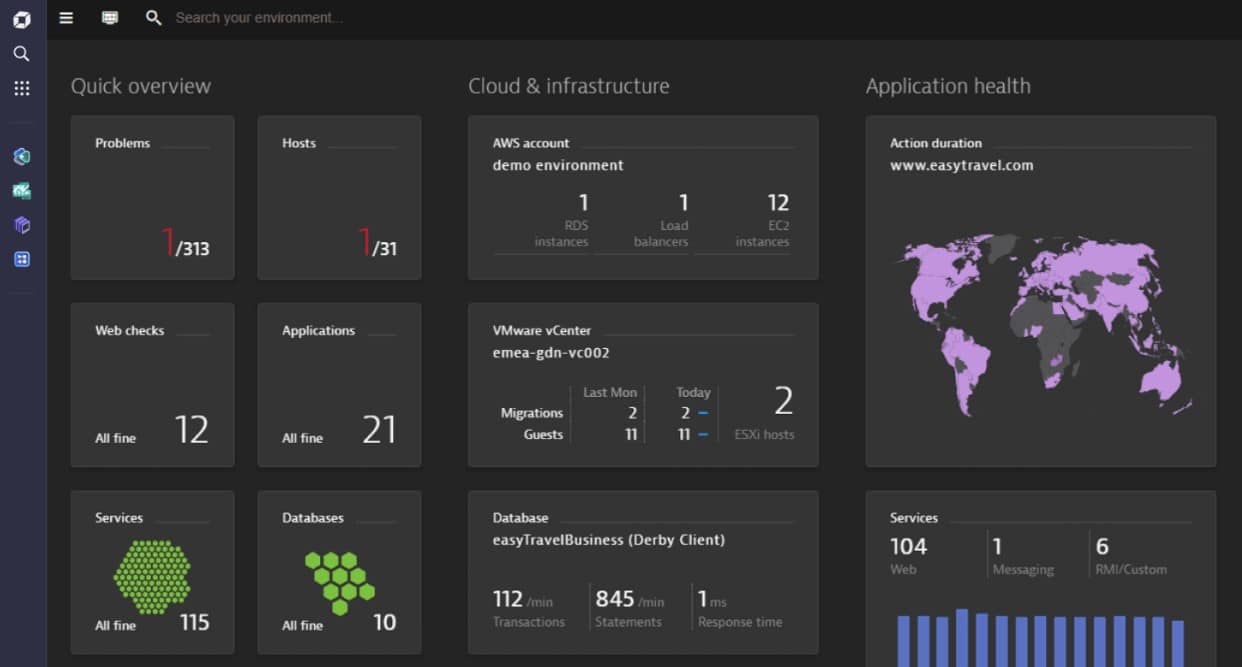
Dynatrace is a cloud-based observability platform that gives visibility into apps, infrastructure, and user experience from start to finish. The platform has a wide range of features and capabilities, making it a popular choice for IT teams trying to monitor and optimize application performance. Dynatrace's AI-powered root cause analysis is one of its notable features. The technology employs advanced machine learning algorithms to automatically detect and diagnose performance issues, allowing IT staff to remedy problems before they affect users.
Key Features:
- AI-powered analysis
- Real-time analytics
- Hybrid cloud support
- Automatic anomaly detection
- Tracing capabilities
Dynatrace also contains a comprehensive set of monitoring tools, such as real-time analytics, automatic anomaly identification, and tracing. The technology allows IT professionals to swiftly detect and manage performance issues by providing visibility into every transaction and interaction throughout the entire IT stack. Furthermore, Dynatrace supports hybrid and multi-cloud systems. The platform can monitor applications and infrastructure on Amazon, Azure, and GCP cloud platforms, as well as on-premises systems.
Dynatrace pricing is dependent on use, with costs beginning at $10,000 per year for up to 100 hosts. The platform also provides a free trial, allowing IT teams to test the platform's capabilities before making a purchase.
One disadvantage of Dynatrace is its complexity. The platform has many features and capabilities, which can make it difficult for some users to browse and use it efficiently. Also, some users have noted that the platform might be resource-intensive, affecting the operation of the systems being monitored.
4. New Relic
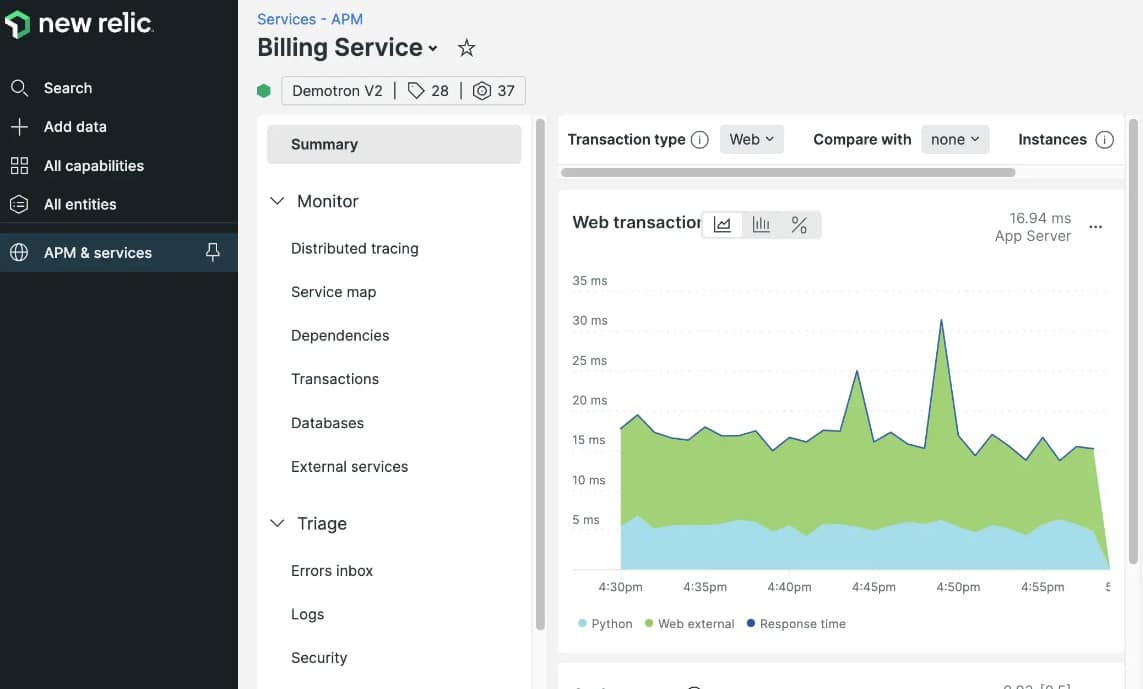
New Relic is a cloud-based observability platform that provides real-time application, infrastructure, and user experience monitoring and analysis. The platform has a wide range of features and capabilities, making it a popular choice for IT teams trying to maximize application performance.
Key Features:
- Multi-language support
- Real-time analytics
- Cloud platform monitoring
- Container monitoring capabilities
- Automatic anomaly detection
One of New Relic's notable advantages is its support for a diverse set of programming languages and frameworks. The platform contains pre-built integrations for over 20 programming languages and frameworks, allowing IT teams to monitor their applications fast and efficiently regardless of the technologies utilized.
New Relic also contains monitoring features such as real-time analytics, automatic anomaly identification, and transaction tracing. The technology allows IT professionals to swiftly detect and manage performance issues by providing visibility into every transaction and interaction throughout the entire IT stack. New Relic also supports cloud platforms such as Amazon, Azure, and GCP, as well as on-premises settings. The platform also provides monitoring features for containers and microservices, making it an invaluable tool for enterprises implementing these technologies.
One disadvantage of New Relic is its complexity. The platform has many features and capabilities, which can make it difficult for some users to browse and use it efficiently. Furthermore, some customers have claimed that the platform's cost is very high in comparison to comparable observability technologies. New Relic pricing is dependent on use, with infrastructure monitoring starting at $0.25 per GB per month and APM monitoring starting at $149 per month. The platform also provides a free trial, allowing IT teams to test the platform's capabilities before making a purchase.
5. Splunk
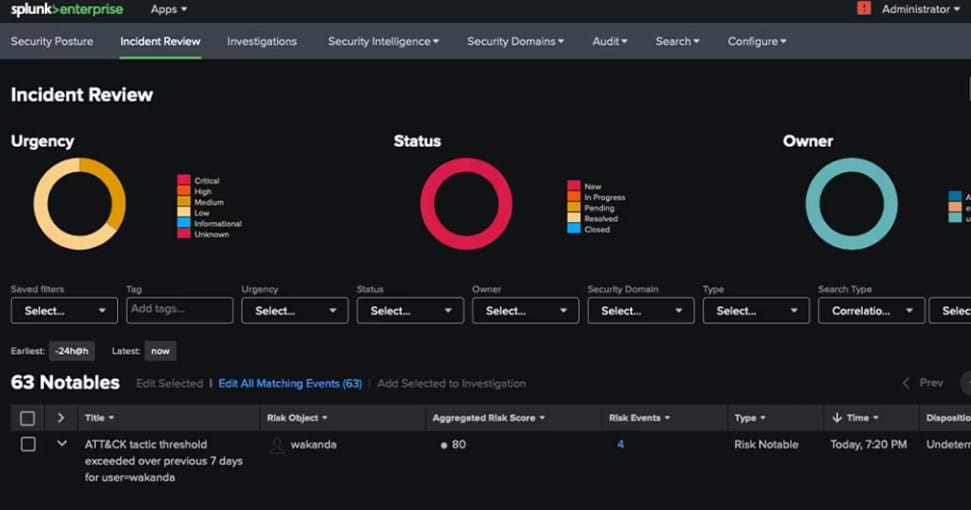
Splunk is a prominent observability platform that delivers real-time application, infrastructure, and security monitoring, analysis, and troubleshooting. The platform contains a wide range of features and capabilities, making it a vital tool for IT teams trying to optimize the performance of their settings.
Key Features:
- Real-time analytics
- Machine learning
- Anomaly detection
- Third-party integrations
- Customizable platform
One of the notable aspects of Splunk is its versatility. The platform can be tailored to suit a variety of use cases, such as IT operations, DevOps, security, and business analytics. This adaptability enables IT teams to customize the platform to their individual requirements, ensuring they have the visibility and insights required to fulfill their objectives.
Splunk also contains monitoring features such as real-time analytics, machine learning, and anomaly detection. The platform can evaluate and correlate data from numerous sources, including apps, servers, networks, and security technologies, offering broad visibility into the IT environment. Splunk also supports numerous connectors with third-party tools and platforms, such as cloud providers, DevOps tools, and security solutions. As a result, it is a beneficial tool for enterprises that operate with a variety of technologies and platforms.
Pricing for Splunk is based on usage, with prices starting at $1,800 per year for up to 1 GB of daily indexing volume. The platform also offers a free trial, which enables IT teams to test the platform's capabilities before committing to a purchase. Splunk's complexity could be a disadvantage. The platform has many features and capabilities, which can make it difficult for some users to browse and use it efficiently. Furthermore, some customers have claimed that the platform's cost is very high in comparison to comparable observability technologies.
6. AppDynamics
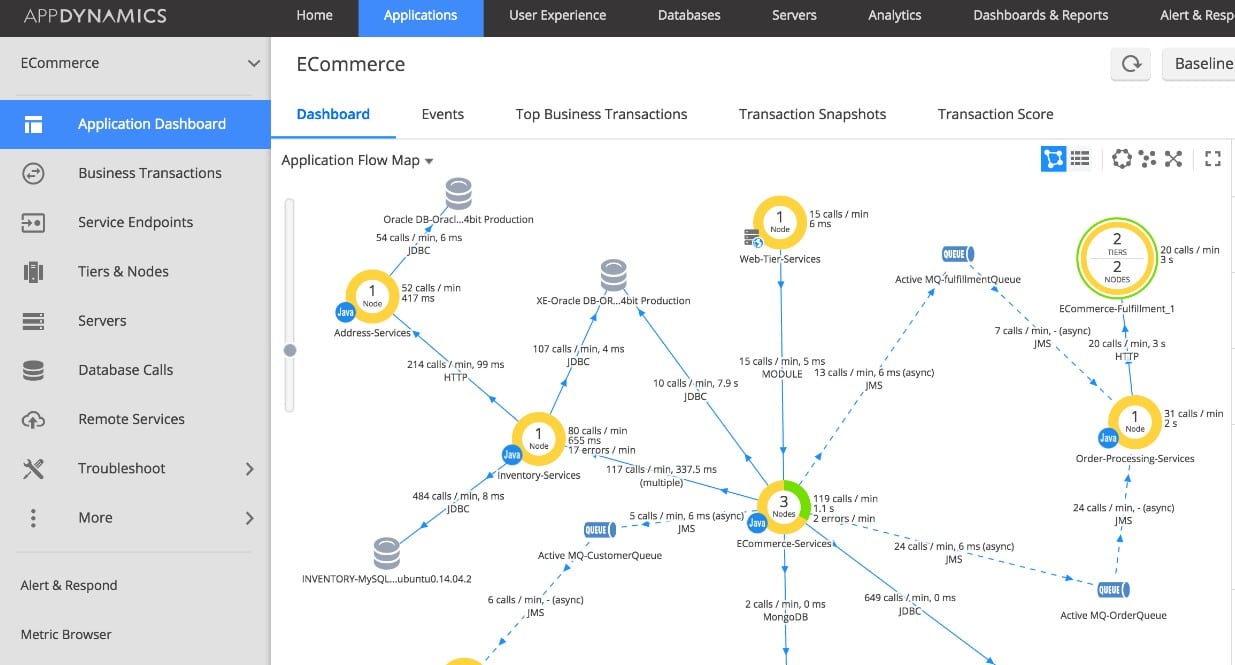
AppDynamics is an observability platform that provides real-time visibility into the performance of complex applications and infrastructure. The platform has several features and capabilities that make it an important tool for IT teams wanting to improve the performance of their environments.
Key Features:
- Deep application visibility
- Advanced analytics
- Incident management
- ChatOps capabilities
- Collaboration tools
AppDynamics' ability to provide extensive visibility into the performance of applications, encompassing both front-end and back-end components, is one of its distinguishing characteristics. The platform can track transactions, code, and infrastructure to provide a comprehensive picture of application performance.
AppDynamics also has extensive analytics and machine learning capabilities, allowing it to detect trends and abnormalities in performance data. This can assist IT staff in proactively identifying and resolving issues before they have an impact on end users. AppDynamics also contains a variety of collaboration and communication features, such as incident management and ChatOps capabilities. This can help IT teams work more efficiently and effectively, allowing them to respond to problems and fix difficulties more quickly.
AppDynamics pricing is per-license, with costs starting at $3,600 per year for a single agent license. The platform also provides a free trial, allowing IT teams to test the platform's capabilities before making a purchase.
One disadvantage of AppDynamics is its complexity. The platform has many features and capabilities, which can make it difficult for some users to browse and use efficiently. Furthermore, some customers have claimed that the platform's cost is very high in comparison to comparable observability technologies.
7. Sysdig Monitor
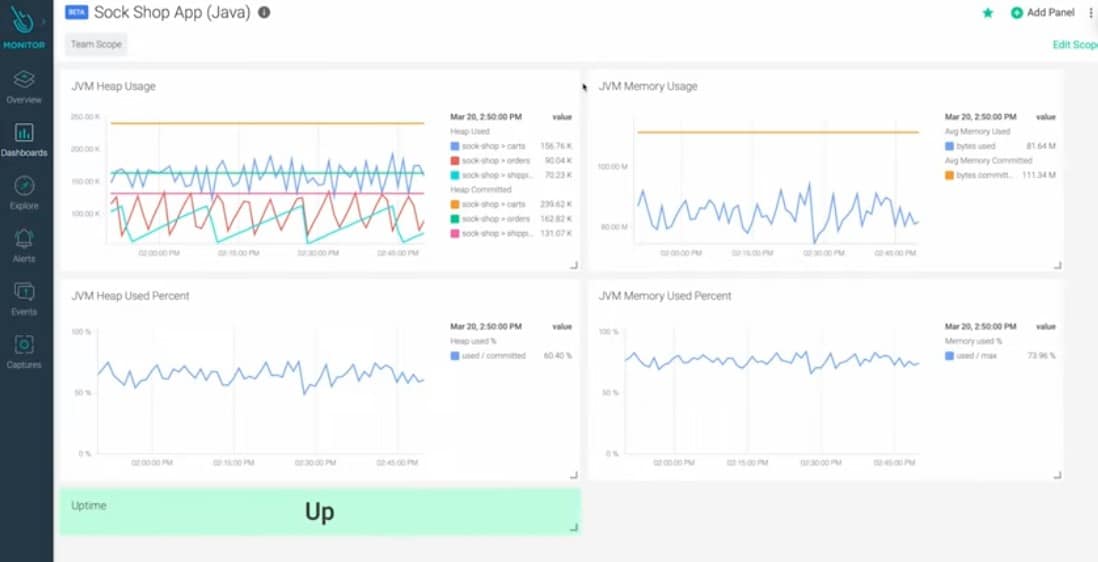
Sysdig Monitor is a cloud-native observability tool that provides deep visibility into cloud environment performance. The platform contains a number of features and capabilities that make it an invaluable resource for IT teams trying to improve the performance of their hybrid cloud infrastructure.
Key Features:
- Real-time visibility
- Advanced analytics
- Incident management
- ChatOps capabilities
- Cloud-native observability
One of Sysdig Monitor's most notable features is its ability to provide real-time visibility into the performance of applications, infrastructure, and containers. The software can monitor Kubernetes clusters, Docker containers, and cloud services, giving you a complete picture of your infrastructure.
Advanced analytics and machine learning capabilities are also included in Sysdig Monitor, allowing the platform to discover trends and abnormalities in performance data. This can assist IT staff in proactively identifying and resolving issues before they have an impact on end users. Furthermore, Sysdig Monitor contains a number of collaboration and communication features, such as incident management and ChatOps. This can help IT teams work more efficiently and effectively, allowing them to respond to problems and fix difficulties more quickly.
Sysdig Monitor is priced per license, with pricing beginning at $20 per month per node. The platform also provides a free trial, allowing IT teams to test the platform's capabilities before making a purchase. One disadvantage of Sysdig Monitor is its complexity. The platform has many features and capabilities, which can make it difficult for some users to browse and use efficiently. Furthermore, some customers have claimed that the platform's cost is very high in comparison to comparable observability technologies.
